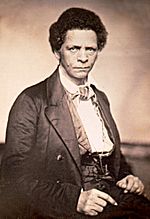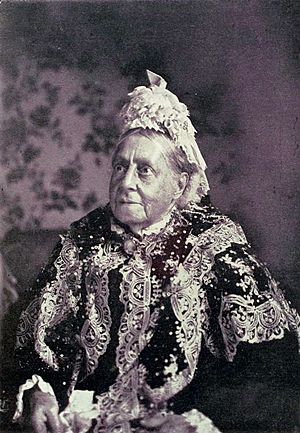Jane Roberts (first lady) facts for kids
Quick facts for kids
Jane Roberts
|
|
|---|---|
 |
|
| Born |
Jane Rose Waring
c. 1819 Virginia, United States
|
| Died | January 10, 1914 (aged 94–95) |
| Resting place | Streatham Cemetery London, England |
| Nationality | American (Before 1824) Liberian (After 1824) |
| Spouse(s) |
|
Jane Rose Waring Roberts (born Waring; around 1819 – January 10, 1914) was an important figure in the early history of Liberia. She moved there as a child with her family, who were free African-Americans from the United States. In Liberia, she grew up as part of the Americo-Liberian community.
Jane married Joseph Jenkins Roberts, who became the first governor of the Colony of Liberia. When Liberia became an independent country, he was elected its first president. This made Jane Roberts the first First Lady of the Republic of Liberia. She served in this role from 1848 to 1856 and again from 1872 to 1876. She often traveled with her husband on important trips to other countries. She also worked to help women get a good education.
After her husband passed away, Jane Roberts traveled to the United Kingdom. She worked to raise money to build a hospital in Monrovia, Liberia's capital. During this time, she met Queen Victoria for a second time. From 1906 until she died, Jane lived in London with a British politician, John Archer, and his wife. She was buried in Streatham Cemetery in London.
Contents
Jane Roberts' Early Life
Jane Rose Waring was born free in Virginia, United States, around 1819. She was one of several children in the Waring family. Her family was well-known in Virginia's large community of free black people. Her father, Colston Waring, was a minister and a successful businessman.
He decided to sell his property in the United States. He then moved to Liberia through the American Colonization Society. This group helped free black people from America move to the new colony in West Africa.
Moving to Liberia
Jane's mother and her six children, including four-year-old Jane, followed her father. They arrived in Liberia on February 13, 1824, after sailing on a ship called the Cyrus. Sadly, two of Jane's brothers died from fever in their first year. Two more older siblings passed away in 1828.
The family settled in Monrovia, which is now the capital of Liberia. Her father started a successful business there. Colston Waring also became a leader in the colony as a vice colonial agent. He died in 1838.
Jane Waring received her education in Monrovia. She learned to read and write well. She also became fluent in French, as well as English. Throughout her life, she supported Christian charities and worked to improve education for women.
Marriage and Family Life
In 1836, when she was about 17, Jane Waring married Joseph Jenkins Roberts. He was a merchant who was born free in Virginia. He had moved to Liberia in 1829 with his young family. Sadly, his first wife and baby died within a year of arriving in Monrovia.
Jane's marriage to Joseph Roberts brought their two important families together. This helped them gain even more wealth and social standing. Jane and Joseph had one child together, a daughter named Sarah Ann Roberts, born in 1838. They sent Sarah Ann to England for much of her schooling. Sarah Ann later married William A. Johnson.
Jane Roberts' Political Role
Joseph Jenkins Roberts became an important political leader. He served as the governor of Liberia from 1842 to 1848. During this time, Jane Roberts acted as the first First Lady. She also helped with farming, like raising turkeys. She played a part in educating some Liberian children.
In 1847, the Republic of Liberia declared its independence from the United States. Joseph Roberts was then elected as the first president. He served as president until 1856. His long time in office made his wife, Jane, a very influential first First Lady of the new nation.
President Roberts made many diplomatic visits to other countries. He met with several leaders to help Liberia gain recognition as an independent nation. His wife Jane sometimes went with him. They traveled to places like Barbados, the United States, England, Belgium, and France.
When they visited England, Queen Victoria welcomed them on her royal yacht. She honored them with a special seventeen-gun salute. The couple returned to Monrovia on a British warship. The French President, Louis Napoleon III, met with them twice, including in 1851. Later, his government gave equipment to the Liberian military.
In 1856, Joseph Roberts left the presidency. He then became the president of the newly formed Liberia College. He held this position until 1872. That year, he returned to politics and was re-elected as Liberia's president. Jane Roberts again served as the First Lady.
In 1872, Jane lost both her sister, Susannah (Waring) Lewis, and her mother, Harriet (Graves) Waring Brander. Her mother had remarried to Nathaniel Brander, who was also a politician. He served as Vice-President with Joseph Roberts.
Joseph Roberts died in 1876, shortly after he resigned from the presidency. Jane had tried her best to care for him when he was ill.
Life as a Widow and Passing
Even after her husband passed away, Jane Roberts remained active in her community. In 1887, she started a project to build a hospital in Monrovia. To raise money, she visited the United States. There, she had dinner with President Grover Cleveland and his wife at the White House. She was the only black woman to do so at that time. President Cleveland also gave money to the hospital project. In 1891, she spoke at a meeting of the Pennsylvania Colonization Society. This group had supported American settlement in Liberia.
In July 1892, Jane Roberts represented her government in a second meeting with Queen Victoria. This meeting took place at Windsor Castle. Jane was there to present a special quilt to the queen. The quilt was made by an Americo-Liberian woman named Martha Ann Erskine Ricks. Martha had worked on the quilt for twenty-five years. Roberts and the Liberian ambassador arranged for Martha Ricks to come along and give the quilt to Queen Victoria herself.
Years later, an African-American artist named Elton Fax drew a quick picture of this meeting. He also drew a larger portrait of Jane Roberts, based on a 1905 photograph. He called it "They'll Never Die." This short piece was published in newspapers in 1949.
Jane Roberts returned to England after the year 1900. From 1906 until her death, she lived in London with a British couple. They were politician John Archer, who was the first black mayor of Battersea, and his wife Bertha. In England, she continued to raise money for the Monrovia hospital. She often received gifts from friends. Hallie Quinn Brown visited Jane in 1910 and noted that Roberts, at 91 years old, was still "clear in mind and wonderfully active."
On January 10, 1914, Jane Roberts passed away in the Archer home. She was one of the oldest members of the Liberian community. She was buried at Streatham Cemetery in London.
Images for kids





